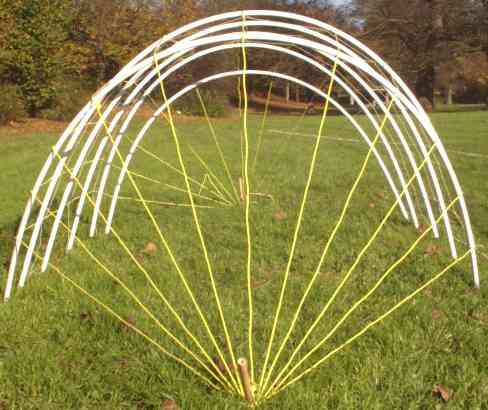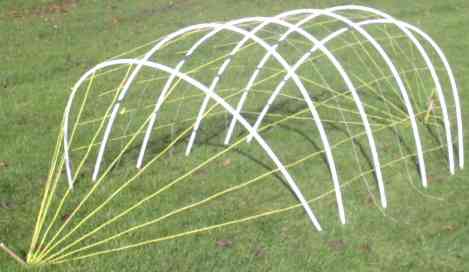
Polytunnels
Polytunnel ubiquity
The polytunnel is a widespread structure of considerable
economic importance.
Polytunnels facilitate growing sensitive, tropical fruiting
plants in northern climes - where much of the planet's
landmass and population reside.
Polytunnel problems
Current polytunnel construction methods tend to use sparse
structural elements.
These usually serve dual roles: supporting the structure
against gravity and supporting the polythene.
The result is often significant stress points - where the
force in the polythene is concentrated many times over.

Polytunnel stress points
These stress points are where the covering ultimately goes
through.

Cable tunnel
Using a net
This site is devoted to the idea of using sparse fabrics to
provide supplementary support for the polythene in tunnels.
The basic idea is to divorce the roles of structural support
for the whole structure and supporting the polythene - and
use differing structures for each task.
Essentially, this is likely to means using some sort of net
to provide an external curved surface - and then stretching
the polythene over that.
This fabric then takes the strain from the structural
elements - rather having it transmited straight into the polythene.
The fabric should be substantially less elastic than
polythene - so it results in a surface that is close to
being cylindrical.
Because such a fabric would have more regular structural
elements, there would be no large areas where the polythene
is unsupported - and so the strains where it is
supported would be reduced.
Such a net could also play the role of insulator - thermally
insulating the polythene from the structural elements.
Longitudinal elements
The illustrate net consists primarily of cables running parallel
to the axis of the tunnel.
That's essentially because the polythene curves
perpendicular to this direction - and shouldn't curve much
in any other direction.

Cable tunnel
Net drawbacks
-
Material costs
The material of the net costs money - and nets take time to
install, and create an additional light barrier.
However the idea of using a net is to provide better support for
the polythene cover - and maintenance costs associated with the
cover are responsible for many of the costs of operating a tunnel.
More structural support for the polythene from a net could
result in a reduced need for primary structural elements -
since they no longer have to play the role of directly
supporting the polythene. In theory, these could be
drastically reduced - so the tunnel comes to
consist primarily of polythene-covered net.
Since the polythene is no longer subjected to such
great stresses - it should be possible to either use
cheaper coverings - or get a longer lifespan.
-
Installation costs
The net takes some time to install. Hopefully it will pay
for itself in terms of decreased maintenance costs
associated with the cover it acts to protect.
-
Blocking light
Use of a net is likely to result in some on the incident
light being blocked.
However the net does not need to be very dense to
perform its primary function.
The effect is quantified later on this page.
-
Drips
Lastly, a net interferes with the passage of condensation
down the inside of the polythene, and increases the quantity
of water that will drip into the main body of the
structure.
Is it practical to use only the net to insulate the polythene cover?
It's possible to calculate the quantity of cable that's
needed to lift the polythene just free of the
structural supports.
The idea here would be to make the net play the role of
thermal insulator - as well as the role of physical
support.
The maths involved is fairly simple:
In the following, R1 is the radius of the tunnel, R2 is
the radius of the cable.
%obscured = 100 × R2 ÷ (R1 × ACOS(R1 ÷ (R1 + 2 × R2)));
The following table show the percentage of incident light that will
be blocked by the net.
| R2\R1 |
2000mm
|
3000mm
|
4000mm
|
5000mm
|
| 2mm |
1.6% |
1.3% |
1.1% |
1.0% |
| 4mm |
2.2% |
1.8% |
1.6% |
1.4% |
| 6mm |
2.7% |
2.2% |
1.9% |
1.7% |
| 8mm |
3.1% |
2.6% |
2.2% |
2.0% |
To present a textual summary:
- Thinner strands block less light
(despite the fact that more of them are needed).
- Using a polytunnel with a larger radius decreases the
proportion of incident light blocked.
Material
One of the possible materials for use in constructing a net
for this sort of application is plastic covered steel wire.
Such wire is often built for applications such as washing
lines - and is available inexpensively.
Woven tunnels
We also have a page about the possibilities of woven tunnels.
Tim Tyler |
Contact |
http://hexdome.com/
|